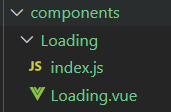在介绍vue项目定义全局方法与组件之前,需要介绍下Vue.use的使用
Vue.use( plugin , options)
参数:
plugin 插件 {Object | Function}
options 选项参数 数据类型任意
用法:安装 Vue.js 插件。如果插件是一个对象,必须提供 install 方法。如果插件是一个函数,它会被作为 install 方法。install 方法调用时,会将 Vue 作为参数传入。
/**
* plugin作为不同参数示例
**/
// Object
export default {
install (Vue, options) {
Vue.prototype.$console = () => {
console.log('hello world')
}
}
}
// Function
export default (Vue, options) => {
Vue.prototype.$console = () => {
console.log('hello world')
}
}
该方法需要在调用 new Vue() 之前被调用。
当 install 方法被同一个插件多次调用,插件将只会被安装一次。
参考:插件
用 axios时,不需要用 Vue.use(axios),因为axios本身就不是Vue的组件,是个同时支持node端和浏览器端的http库。
vue项目定义全局方法
公共js文件,比如common.js通过export default暴露出来
export default {
install(Vue, options){
Vue.prototype.方法名 = function(){
}
}
}
在入口文件main.js引入
import commonJs form './utils/common'
Vue.use(commonJs)
然后就可以全局使用common.js里面的方法了,this.方法名
vue项目定义全局组件
1.创建如下图中的文件夹和文件

2.在 Loading.vue 中定义一个组件
<template>
<div>
Loading
</div>
</template>
3.在 index.js 中 引入 Loading.vue ,并导出
// 引入组件
import LoadingComponent from './Loading.vue'
// 定义 Loading 对象
const Loading = {
install (Vue, options){
Vue.component('Loading',LoadingComponent)
}
}
// 导出
export default Loading
4.在 main.js 中引入 Loading 文件下的 index
// 其中'@/components/Loading/index' 的 /index 可以不写,webpack会自动找到并加载 index 。如果是其他的名字就需要写上。
import Loading from '@/components/Loading'
// 这时需要 use(Loading),如果不写 Vue.use()的话,浏览器会报错,大家可以试一下
Vue.use(Loading)
5.在App.vue里面写入定义好的组件标签
<template>
<div id="app">
<h1>vue-loading</h1>
<!-- 此处组件引用需要将驼峰法命名修改为'-'命名,且都是小写 -->
<loading></loading>
</div>
</template>